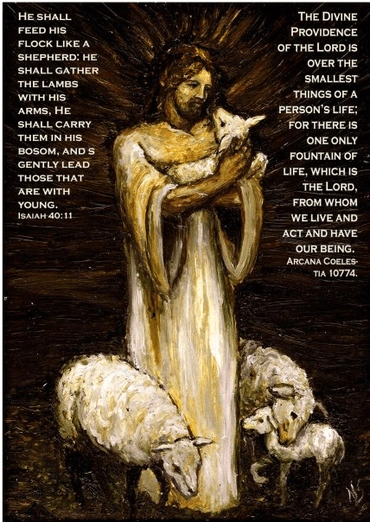493. These are the two olive trees and the two lampstands standing before the God of the earth. (11:4) This symbolizes love and intelligence, or charity and faith, both of which people have in them from the Lord.
An olive tree symbolizes love and charity, as explained below. And a lampstand symbolizes enlightenment in truths (no. 43), thus intelligence and faith, inasmuch as intelligence comes from an enlightenment in truths, and faith in turn from this. To stand before God means, symbolically, to hear and do what He has commanded (no. 366). Here, therefore, it means that these two characteristics in them come from the Lord who is God of the earth, that is, in people who possess the two essential elements of the New Church, as described above. It is apparent from this that the statement that the two witnesses were the two olive trees and two lampstands means, symbolically, that they were love and intelligence, or charity and faith. For these two form the church - love and charity forming its life, and intelligence and faith its doctrine.
[2] An olive tree symbolizes love and charity because the olive tree symbolizes the celestial church, and thus an olive, being its fruit, symbolizes celestial love, which is love toward the Lord. Because of this, that love is symbolized also by olive oil, with which all the holy accouterments of the church were anointed. The oil called holy oil 1
was extracted from olives and mixed with spices (Exodus 30:23-24). Olive oil was also used to light the lamps of the lampstand in the Tabernacle every evening (Exodus 27:20, Leviticus 24:2).
The olive tree and olives have similar symbolic meanings in Zechariah:
Two olive trees were by (the lampstand), one at the right of the bowl, the other at its left..., (and) two olive berries... These are the two offspring of the olive tree, which stand before the Lord of the whole earth. (Zechariah 4:3, 11-12, 14)
In the book of Psalms:
I am like a green olive tree in the house of God. (Psalms 52:8)
And in Jeremiah:
Jehovah called your name, Green Olive Tree, lovely, of beautiful fruit. (Jeremiah 11:16-17)
And so on elsewhere.
[3] Since Jerusalem symbolized the church, therefore many things in it and about it also symbolized such things as are connected with the church. Near it, too, was the Mount of Olives, and it symbolized Divine love, which is why Jesus "was during the days in the temple teaching, and at night He went out and spent the night on the Mount of Olives?" (Luke 21:37, cf. 22:39, John 8:1). It is also why Jesus spoke with His disciples on that mountain regarding the end of the age and His coming then (Matthew 24:3ff., Mark 13:3ff.). It was also from that mountain that He went to Jerusalem and suffered the cross (Matthew 21:1; 26:30, Mark 11:1; 14:26, Luke 19:29, 37). Moreover, this accorded with the prediction in Zechariah:
In that day His feet will stand on the Mount of Olives, which faces Jerusalem on the east. (Zechariah 14:4)
Because the olive tree symbolized the celestial component of the church, therefore the cherubim inside the Temple at Jerusalem were made of olive wood, and so, too, were the doors to the inner sanctuary, and the doorposts (1 Kings 6:23-33).
Notas a pie de página:







